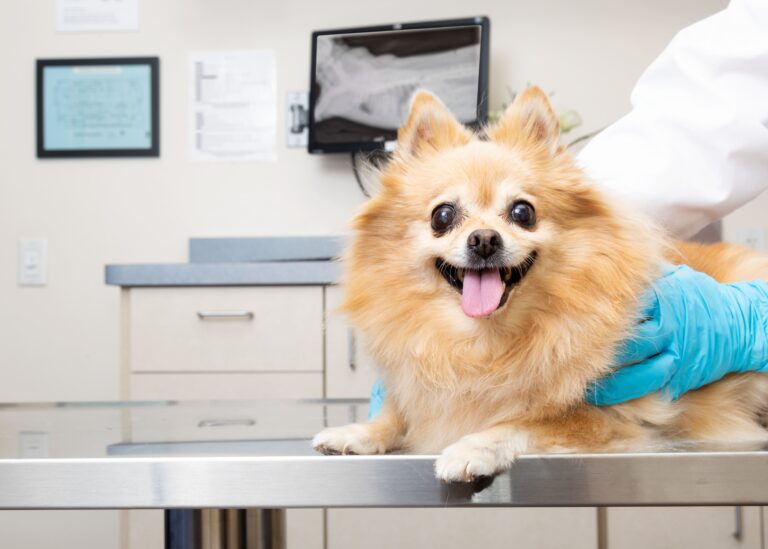Dog Cancer: Causes, Symptoms and Treatments
Cancer is a common disease in dogs, which becomes more and more prevalent as the longevity of our four-legged companions progresses.
For many owners, the news of cancer in their dog is extremely difficult to overcome because, in their minds, it signals the death warrant of their furry best friend.
However, there are actually effective treatments for cancer in dogs, although the disease remains serious and has a high lethal potential.
Today, I invite you to learn more about cancer pathologies for dogs, their causes, consequences, possible treatments and, above all, their health prognosis.
What is cancer in dogs?
Cancer in dogs develops the same way as in humans. This is an uncontrolled proliferation of certain cells in the body, which form constantly growing masses, called malignant.
These masses are commonly referred to as tumors or neoplasms. It is essential to note that not all tumors and neoplasias are cancerous: there are malignant masses, and benign masses. Only malignant masses are qualified as cancers.
All cells in the body, regardless of their tissues or organs, can cause cancerous tumors.
When cancerous tumors grow from cells located on non-vital organs, such as the skin, they are not directly fatal, unless they grow so large that they end up bleeding by tearing, which in turn causes the cancer to grow. all in all very rarely.
The main danger of cancer is the process of metastasis, in which cancer cells break away from the original tumor to migrate to other organs and form secondary tumors there.
When these secondary tumors reach vital organs in the dog, invariably impairing their function, the animal’s prognosis is grim.
Furthermore, since metastases have the ability to spread throughout the body before forming new tumors, they are difficult, if not impossible, to detect by medical imaging, and therefore cannot be treated effectively.
Depending on their starting cells, cancers do not progress in the same way and do not cause the same clinical signs. Some tumors are particularly aggressive, while others grow more slowly to metastasize and offer a better prognosis.
It is essentially the origin of each cancer that allows it to be qualified and to prejudge its course and characteristics.
Mast cell cancer, the most common skin cancer in dogs, arises from mast cells, white blood cells in connective tissue that are found on most organs.
To cite other examples of cancers frequently encountered in dogs, carcinoma develops from cells of the epithelium (skin and mucous membranes), lymphoma originates from cells of the lymphatic system, sarcoma originates from soft tissues (visceral ) or bone …
All these cancers are then divided into sub-categories allowing to refine their identification: in the family of sarcomas, for example, we have hemangiosarcoma, coming from vascular cells, insulinoma, which comes from pancreatic cells responsible for secretion insulin, osteosarcoma, chondrosarcoma …
In the USA, cancer is the number one killer of dogs, followed by heart disease, diabetes and kidney failure.
Certain breeds seem to be predisposed to cancerous pathologies, as is especially the case of the Boxer, but also, to a lesser extent, of the Bernese Mountain Dog, the Golden Retriever, the Scottish Terrier and the Bouvier des Flandres.
This is a condition that mainly develops in older animals, although it can affect dogs of any age. It is estimated that 50% of dogs over 8 years old have cancer.
Causes of cancer in dogs
In dogs, as in humans, cancer is considered to be a multifactorial disease, the mechanisms of occurrence of which are still very complex and poorly understood.
In fact, it is difficult to determine a precise cause of cancer, but on the other hand, there are multiple contributing factors that can act alone or in concert on the dog’s body and give rise to neoplasias.
Among the contributing factors most often mentioned are genetic predispositions, environmental factors and age.
Hereditary cancers in dogs
Genetic predispositions have long been suspected of being involved in the development of cancer, although it is not yet known exactly how and why.
However, it is known that inbreeding has long been associated with the development of cancer in purebred dogs. Family cancer pathologies are indeed observed, especially in Boxer and Bernese Mountain Dogs.
More than 50% of Bernese Mountain Dogs, of all ages, eventually die of cancer, and more particularly of the same types of cancer, namely histiocytic sarcoma and lymphoma.
The Boxer, meanwhile, is predisposed to the development of mast cells and other skin tumors, cancerous or not.
Environmental factors and dog cancer
Many chemical and food compounds integral to our daily environment have long been identified as carcinogens in humans and animals.
As dogs increasingly share the lifestyle of their owners, they are more exposed to carcinogens found in our environment.
Thus, dogs living in cities and in polluted areas are more frequently overwhelmed by lung and respiratory cancer than rural doggies.
Preservatives and chemicals found in industrial dog food (which, let’s remember, is a fairly new way of eating for our four-legged friends) are also likely to be responsible for cancer.
Other common carcinogenic compounds found in our environment include ultraviolet rays, cigarette smoke, insecticides, pesticides, heavy metals and asbestos.
Aging and cancer in dogs
Age is known to be a significant predisposing factor for cancer, and most cancerous tumors are found in dogs over 10 years of age.
In fact, it is cell division that is at the origin of neoplasias, which occur when this process does not go quite as expected, with cell reproduction suddenly becoming anarchic.
The older the animal, the more its body will go through many cycles of cell regeneration, and the more likely it is that misfires will occur during these cycles, giving rise to the birth of cancerous tumors.
Paradoxically, the advance of veterinary medicine and the involvement of owners in the health of their four-legged companions have caused a sharp increase in the occurrence of cancer in dogs.
For good reason, dogs now live older than before, and are therefore more likely to develop so-called “senile” diseases, that is to say, occurring due to the natural aging of their cells.
Symptoms of cancer in dogs
Symptoms of cancer in dogs vary depending on the location of the original tumor and, possibly, its metastasis.
When the tumor is localized to external tissues (skin, mucous membrane, etc.), it may be possible to see or feel an abnormal mass.
When it is localized on internal organs (lung, liver, pancreas, intestines, etc.), it is completely invisible and often asymptomatic, unless it interferes with the functioning of the affected organ or neighboring tissues that it risks compress while magnifying.
In this case, the clinical signs are specific to the organ concerned. A tumor in the lungs, for example, will cause breathing problems, while a bone tumor can cause lameness and a brain tumor can cause neurological disturbances.
It is also sometimes possible to see general symptoms, regardless of the location of the tumor and its original cells, but these are far from systematic.
Dogs tend to be tired, may have episodes of fever, may lose weight, lose their appetite, show some sadness, or show signs of pain.
Unexplained deterioration in the general health of the dog can perfectly reflect cancer, and should always be taken seriously by the owner.
How to deal with veterinary costs in the event of illness or accident?
To avoid high health costs, I urge you to look into dog insurance.
To find the offer that suits you best and at the best price, you can use this free comparator which will allow you to save up to 60% on your costs.
Treatment and prognosis of cancer in dogs
The news of cancer often sends shivers down your spine, and many teachers will be tempted to give up when they hear this terrible news.
However, there are anti-cancer treatments suitable for dogs, which can offer the animal many months or additional years of life in good conditions, even offer it a complete cure – although this is still quite rare today.
Like humans, dogs with cancer may benefit from chemotherapy, radiation therapy, and / or surgical removal of the tumor. The choice of the most suitable treatment is made according to the animal’s state of health and the characteristics of the tumor.
The treatment can be curative, that is to say aiming to cure definitively, or palliative, that is to say intended to improve the comfort of the dog and to slow the progression of his disease to increase his life expectancy. . Most of the time, the treatment of cancer in dogs is palliative.
Since the treatments exist, it is therefore the involvement of the teacher which is at stake. It is advisable to question the interest, practical, economic, but also ethical, to offer months or years of additional life to his dog, while improving his quality of life – a detail that is important!
On the one hand, it should be noted that cancer treatments in dogs will often have a great impact on their comfort by significantly reducing the symptoms they may be experiencing.
Second, it is important to put the few extra months of life that your dog could benefit from in the scale of his longevity: for a dog, who lives 11 years on average, 6 months of life represents 42 months for a human who lives 79 years on average, almost 4 years.
From your perspective as a human being, the extra 6 months of life a dog could enjoy with treatment may seem like a pittance and may go by lightning speed, but, for him, it’s a long stretch. a long way that he could still travel by your side.
Finally, it is essential to note that the evolution of cancer is never really certain, because it depends on many criteria and is unique to each doggie.
The established prognosis is therefore always uncertain, since it cannot take into account the unique characteristics of your pooch, its organism never reacting in exactly the same way as that of another animal, even if it is of the same age and of the same race.
Frequently Asked Questions
Can my dog be cured of cancer?
Yes, some cancers can be completely cured in dogs, but this is currently anecdotal.
In the vast majority of cases, cancer treatments in dogs are palliative, that is, aimed at prolonging the life of the animal and increasing its comfort.
Can we cure cancer in dogs?
Yes, dog cancer can be treated with chemotherapy, radiation therapy and / or surgery.
However, in most cases, this type of therapy is aimed at improving the dog’s comfort and prolonging his life expectancy, but does not prevent recurrence.
What is the life expectancy of a dog with cancer?
All cancers progress differently depending on their own characteristics and the unique characteristics of each dog, so it is difficult to establish universal prognoses, and talking about survival averages does not make much sense.
The life expectancy of a dog with cancer depends in particular on the stage of development of the cancerous tumor detected, its age, the characteristics of the cancer and the treatments used to control or eliminate the disease.
Can Dogs Get Cancer?
Yes, cancer is not a strictly human disease and animals, such as dogs, can suffer as well.
Cancer is even the number one killer of dogs, and it is estimated that one in two dogs over the age of 10 will develop it in their lifetime.
Cancer is a scary disease, but it’s important not to give up when your dog is diagnosed to help him or her best fight the tumor that is overwhelming him.
There are many treatments available to improve your pet’s comfort, extend his life expectancy, and in rare cases even cure him for good.
Be hopeful, and don’t hesitate to ask your vet for more information if you can’t make an informed decision about what to do next when your dog has cancer. A second medical opinion could also be very helpful.
Is your dog fighting cancer? What treatments have you decided to offer him to improve his daily life? Share your experience by commenting on this article!
Subscribe to our weekly newsletter below and never miss the latest article.









3 Comments